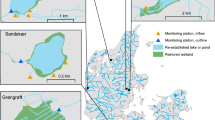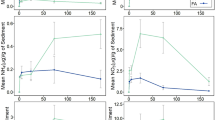Abstract
We compared the mechanisms of nitrogen (N) and phosphorus (P) removal in four young (<15 years old) constructed estuarine marshes with paired mature natural marshes to determine how nutrient retention changes during wetland ecosystem succession. In constructed wetlands, N retention begins as soon as emergent vegetation becomes established and soil organic matter starts to accumulate, which is usually within the first 1–3 years. Accumulation of organic carbon in the soil sets the stage for denitrification which, after 5–10 years, removes approximately the same amount of N as accumulating organic matter, 5–10 g/m2/yr each, under conditions of low N loadings. Under high N loadings, the amount of N stored in accumulating organic matter doubles while N removal from denitrification may increase by an order of magnitude or more. Both organic N accumulation and denitrification provide for long-term reliable N removal regardless of N loading rates. Phosphorus removal, on the other hand, is greatest during the first 1–3 years of succession when sediment deposition and sorption/precipitation of P are greatest. During this time, constructed marshes may retain from 3 g P/m2/yr under low P loadings to as much as 30 g P/m2/yr under high loadings. However, as sedimentation decreases and sorption sites become saturated, P retention decreases to levels supported by organic P accumulation (1–2 g P/m2/yr) and sorption/precipitation with incoming aqueous and particulate Fe, Al and Ca. Phosphorus cycling in wetlands differs from forest and other terrestrial ecosystems in that conservation of P is greatest during the early years of succession, not during the middle or late stages. Conservation of P by wetlands is largely regulated by geochemical processes (sorption, precipitation) which operate independently of succession. In contrast, the conservation of N is controlled by biological processes (organic matter accumulation, denitrification) that change as succession proceeds.
Similar content being viewed by others
References
Ambus, P. and Lowrance, R. 1991. Comparison of denitrification in two riparian soils. Soil Sci. Soc. Am. J. 55: 994–997.
Brady, N.C. 1990. The Nature and Properties of Soils. Macmillan Publishing Co., New York.
Brinson, M.M. 1988. Strategies for assessing the cumulative effects of wetland alteration on water quality. Environ. Mgmt. 12: 655–662.
Broome, S.W., Woodhouse, W.W., Jr. and Seneca, E.D. 1975. The relationship of mineral nutrients to growth ofSpartina alterniflora in North Carolina: I. Nutrient status of plants and soils in natural stands. Soil Sci. Soc. Am. Proc. 39: 295–301.
Broome, S.W., Seneca, E.D. and Woodhouse, W.W., Jr. 1986. Long-term growth and development of transplants of the salt-marsh grassSpartina alterniflora. Estuaries 9: 63–74.
Cooke, J.G. 1992. Phosphorus removal processes in a wetland after a decade of receiving sewage effluent. J. Environ. Qual. 31: 733–739.
Cooper, J.R. and Gilliam, J.W. 1987. Phosphorus redistribution from cultivated fields into riparian areas. Soil Sci. Soc. Am. J. 51: 1600–1604.
Craft, C.B. and Richardson, C.J. 1993a. Peat accretion and N, P and organic C accumulation in nutrient enriched and unenriched Everglades peatlands. Ecol. Appl. 3: 446–458.
Craft, C.B. and Richardson, C.J. 1993b. Peat accretion and phosphorus accumulation along a eutrophication gradient in the northern. Everglades. Biogeochemistry 22: 133–156.
Craft, C.B., Broome, S.W. and Seneca, E.D. 1988. Nitrogen, phosphorus and organic carbon pools in natural and transplanted marsh soils. Estuaries 11: 272–280.
Craft, C.B., Broome, S.W. and Seneca, E.D. 1989. Exchange of nitrogen, phosphorus and organic carbon between transplanted marshes and estuarine waters. J. Environ. Qual. 18: 206–211.
Craft, C.B., Broome, S.W. and Seneca, E.D. 1991. Porewater chemistry of natural and created marsh soils. J. Experimental Mar. Biol. and Ecol. 152: 187–200.
Craft, C.B., Broome, S.W. and Seneca, E.D. 1993. Vertical accretion in microtidal regularly and irregularly flooded estuarine marshes. Estuarine. Coastal and Shelf Science 37: 371–386.
Craft, C.B., J. Vymazal and Richardson, C.J. 1995. Response of Everglades plant communities to nitrogen and phosphorus additions. Wetlands 15: 258–271.
DeLaune, R.D. and Patrick, W.H. Jr. 1980. Rate of sedimentation and its role in nutrient cycling in a Louisiana salt marsh.In: Hamilton, P. and Macdonald, K.B. (ed.), Estuarine and Wetland Processes with Emphasis on Modeling. pp 401–412. Plenum Publishing, New York.
DeLaune, R.D., Reddy, C.N. and Patrick, W.H. Jr. 1981. Accumulation of plant nutrients and heavy metals through sedimentation processes and accretion in a Louisiana salt marsh. Estuaries 4: 328–334.
DuBowey, P.J. and Reaves, R.P. (ed.). 1994. Constructed Wetlands for Animal Wastewater Management — Workshop Proceedings. Purdue University Foundation, West Lafayette, IN.
Faulkner, S.P. and Richardson, C.J. 1989. Physical and chemical characteristics of freshwater wetland soils.In: D.A. Hammer (ed.), Constructed Wetlands for Wastewater Treatment. pp 41–72. Lewis Publishers, Chelsea, Michigan.
Firestone, M.K. 1982. Biological denitrification.In: Stevenson, F.J. (ed.), Nitrogen in Agricultural Soils. pp. 289–326. American Society of Agronomy, Madison, Wisconsin.
Hopkinson, C.S., Jr. 1992. A comparison of ecosystem dynamics in freshwater wetlands. Estuaries 15: 549–562.
Johnston, C.A. 1991. Sediment and nutrient retention by freshwater wetlands: effects on surface water quality. Critical Reviews in Environmental Control 21: 491–565.
Johnston, C.A., Bubenzer, G.D., Lee, G.B., Madison, F.W. and McHenry, J.R. 1984. Nutrient trapping by sediment deposition in a seasonally flooded lakeside wetland. J. Environ. Qual. 13: 283–290.
Kadlec, R.H. 1985. Aging phenomena in wastewater wetlands.In: Godfrey, P.J., Kaynor, E.R., Pelczarski, S. and Benforado, J. (eds), Ecological Considerations in Wetland Treatment of Municipal Wastewaters. pp. 334–350. Van Nostrand Reinhold, New York.
Knight, R.L., McKim, T.W. and Kohl, H.R. 1987. Performance of a natural wetland treatment system for wastewater management. J. Water Poll. Control Fed. 59: 746–754.
Knutson, P.H. 1988. Role of coastal wetlands in energy dissipation and shore protection. p. 161–174.In: Hook, D.D. (ed.), The ecology and management of wetlands. Vol. 1: Ecology of Wetlands. Timber Press, Portland, Oregon.
Lindsay, W.L. and Vlek, P.L.G. 1977. Phosphate minerals.In: Dixon, J.B. and Weed, S.B. (eds), Minerals in the Soil Environment. pp. 639–672. Soil Sci. Soc. Am., Madison, Wisconsin.
Mitsch, W.J. 1992. Landscape design and the role of created, restored and natural riparian wetlands in controlling nonpoint source pollution. Ecological Engineering 1: 27–47.
Mitsch, W.J. and Gosselink, J.G. 1993. Wetlands. Van Nostrand Reinhold, New York.
Mitsch, W.M., Cronk, J.K., Wu, X., Nairn, R.W. and Hey, D.L. 1995. Phosphorus retention in constructed freshwater riparian marshes. Ecolog. Appl. 5: 830–845.
Nixon, S.W. 1980. Between coastal marshes and coastal waters — A review of twenty years of speculation and research on the role of salt marshes in estuarine productivity and water chemistry.In: P. Hamilton, P. and Macdonald, K.B. (ed.), Estuarine and Wetland Processes with Emphasis on Modeling. pp 437–525. Plenum Publishing, New York.
Nixon, S.W. and Lee, V. 1986. Wetlands and water quality —a regional review of recent research in the United States on the role of freshwater and saltwater wetlands as sources, sinks and transformers of nitrogen, phosphorus and various heavy metals. Technical report Y-86-2, prepared by University of Rhode Island for US Army Waterways Experiment Station, Vicksburg, MS.
Odum, E.P. 1969. The strategy of ecosystem development. Science 164: 262–270.
Peterjohn, W.T. and Correll, D.L. 1984. Nutrient dynamics in an agricultural watershed: observations on the role of a riparian forest. Ecol. 65: 1466–1475.
Qualls, R.G. and Richardson, C.J. 1995. Forms of soil phosphorus along a nutrient enrichment gradient in the northern Everglades, Soil Science 160: 183–198.
Reaves R.P., DuBowey, P.J. and Miller, B.K. 1994. Performance of a constructed wetland for dairy waste treatment in LaGrange County, Indiana.In: DuBowey, P.J. and Reaves, R.P. (eds), Constructed Wetlands for Animal Wastewater Management — Workshop Proceedings. pp 43–52. Purdue University Foundation, West Lafayette, IN.
Richardson, C.J. 1985. Mechanisms controlling phosphorus retention capacity in freshwater wetlands. Science 228: 1424–1427.
Richardson, C.J. and Marshall, P.E. 1986. Processes controlling movement, storage and export of phosphorus in a fen peatland. Ecol. Monogr. 56: 279–302.
Richardson, C.J. and P. Vaithiyanathan. 1995. P sorption characteristics of Everglades soils along a eutrophication gradient. Soil Sci. Soc. Am. J. 59: 782–788.
Seneca, E.D., Broome, S.W. and Woodhouse, W.W. Jr. 1985. The influence of duration-of-inundation on development of a man-initiatedSpartina alterniflora Loisel marsh in North Carolina. J. Exper. Mar. Biol. Ecol 94: 259–268.
SFWMD (South Florida Water Management District). 1992. Surface water improvement and management plan for the Everglades: supporting information document. South Florida Water Management District, West Palm Beach, FL.
Tisdale, S.L., Nelson, W.L. and Beaton, J.D. 1985. Soil Fertility and Fertilizers. Macmillan Publishing Co., New York.
Thompson, S.P., Paerl, H.W. and Go, M.C. 1995. Seasonal patterns of nitrification and denitrification in a natural and a restored salt marsh. Estuaries 18: 399–408.
Vitousek, P.M. and Reiners, W.A. 1975. Ecosystem succession and nutrient retention: a hypothesis. BioScience 25: 376–381.
Author information
Authors and Affiliations
Rights and permissions
About this article
Cite this article
Craft, C.B. Dynamics of nitrogen and phosphorus retention during wetland ecosystem succession. Wetlands Ecol Manage 4, 177–187 (1996). https://doi.org/10.1007/BF01879236
Issue Date:
DOI: https://doi.org/10.1007/BF01879236




